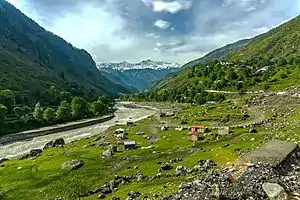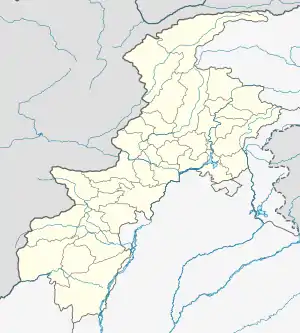Kaghan Valley
کاغان Upper Pakhli | |
|---|---|
 Kaghan photographed during autumn, c. October 2015 | |
 Kaghan Valley  Kaghan Valley | |
| Coordinates: 34°50′N 73°31′E / 34.833°N 73.517°E | |
| Country | |
| Province | |
| District | Mansehra |
| Elevation | 2,500 m (8,200 ft) |
| Time zone | UTC+5 (PST) |
The Kaghan Valley (Hindko, Urdu: وادی کاغان) is an alpine valley in Balakot Tehsil, Mansehra District of Khyber Pakhtunkhwa, Pakistan.[1][2][3] The valley covers a distance of 155 kilometres (96 mi)[4] across northern Pakistan, rising from its lowest elevation of 650 m (2,134 ft) to its highest point at the Babusar Pass around 4,170 m (13,690 ft).[5] Landslides triggered by the devastating 2005 Kashmir earthquake destroyed many passes leading into the valley, though roads have since been largely rebuilt. The Kaghan is a popular tourist attraction in Pakistan.[6][7][8]
Geography
The Kaghan Valley is located in the Hazara region of Pakistan,[9] and borders the Pakistani-administered territories of Gilgit-Baltistan and Azad Jammu and Kashmir to the north and east, respectively. The 155-kilometre-long valley is enveloped by the Lower Himalayan mountain range, resulting in an alpine climate and the prevalence of pine forests and alpine meadows.[10] Alongside the flow of the Kunhar River, the valley features glaciers, crystal-like clear lakes, waterfalls and frosty mountain streams. The Kaghan is known for its scenery and landscapes, resulting in its popularity as a summertime resort amongst locals and tourists alike.[11][12]
Land Revenue
Swati family own 15 villages, Syed family own 7 villages and Mandokhail family own 1 village in Kaghan Valley.[13]
Access
The Kaghan Valley can be reached by road via Balakot through Mansehra and Abbottabad. In Balakot, public buses and other vehicular transport can be used to travel to the valley. Additionally, the Kaghan Valley can also be reached from Peshawar or the national capital of Islamabad by renting a car to Abbottabad or Mansehra; tourists can then order a taxi or other available methods of public transport to go to the valley.
The valley is always accessible during the summer and closed to visitors during winter. This is because glaciers block the roads leading to the Kaghan during winter, although these glaciers typically melt between February and April. From May to the end of September, the roads and Babusar Pass remain open. In May, temperatures can reach up to 11 °C (52 °F) and stoop as low as 3 °C (37 °F).[14]
Folklores
Folk tale of Lalazar
The folk tale of Lala Afghani and Sohni (Lalazar) is intricately linked to the romantic saga of an Afghan youth named Lala and a local maiden named Sohni. Rooted in the cultural fabric of the region, this narrative unfolds as Lala, while passing through the village, becomes enamored with Sohni. However, societal disapproval prevails, leading to the tragic demise of the young man at the hands of the local community.
The site of Lala's sacrifice has since gained renown as Lalazar, with "Zar" signifying the location where Lala made the ultimate sacrifice for his love. Notably, the adjacent forest is christened Sohni da Banr, translating to the forest of Sohni.[15]
In contemporary times, Lalazar has evolved into a well-known village, emerging as a burgeoning tourist destination within the Kaghan valley. Simultaneously, Sohni da Banr retains its prominence as a distinguished forest in the area, preserving the essence of the timeless tale of Lala Afghani and Sohni. The rich cultural heritage associated with Lalazar continues to attract visitors, offering a glimpse into the enduring allure of this captivating narrative.[15]
Folk tale of Munshi and Darshi (Paras)
The romantic saga of Munshi and Darshi (Paras) unfolds against the backdrop of a renowned village called Paras in the Kaghan Valley.[15] During the British colonial era, Munshi, employed as a worker for a company, toiled in the local forest. It was here that he became entangled in a love affair with Darshi, a girl from the community. The clandestine meetings of Munshi and Darshi became the talk of the town, with their love story gaining prominence in the region.
However, societal resistance prevailed, and Munshi faced rejection from the locals, ultimately meeting a tragic end at their hands. The site of this fateful event garnered fame as Darshi da Banr, signifying the forest of Darshi. This woodland has since become a popular destination within the valley, celebrated for its breathtaking beauty, diverse wildlife, and suitability for hiking adventures.
The historical context and cultural nuances of this narrative are reminiscent of the colonial era, reflecting the complexities and challenges faced by individuals navigating societal norms and expectations. The enduring allure of Darshi da Banr serves as a testament to the profound impact of love and tragedy within the tapestry of Kaghan Valley's cultural heritage.
See also
References
- ↑ "Kaghan Valley". tourism.kp.gov.pk. Retrieved 1 May 2019.
- ↑ "Alpine-Climate Valley". www.manhoos.com. Retrieved 24 May 2018.
- ↑ Shakirullah, J Ahmad, H Nawaz (2016). Recent Archaeological Exploration of the Upper Kaghan Valley, Mansehra, Pakistan. Annual Conference on South Asia 45
- ↑ "Length of Valley". www.tourismontheedge.com. Retrieved 23 May 2018.
- ↑ "Elevation of Kaghan Valley". explorepak.wordpress.com. Retrieved 23 May 2018.
- ↑ The Kashmir Earthquake of 8 October 2005 – Earthquake Engineering
- ↑ "Cold wave rules KP, Fata: Snow, landslides block roads in Kaghan valley". www.thenews.com.pk.
- ↑ "Record number of tourists visit Kaghan Valley". www.thenews.com.pk.
- ↑ "Tourists throng scenic Hazara division". Daily Times. 23 July 2021. Retrieved 2 May 2023.
- ↑ Planet, Lonely. "Kaghan Valley travel | Karakoram Highway, Pakistan". Lonely Planet. Retrieved 17 August 2019.
- ↑ "Geographical Elements of the Kaghan Valley". Mapping and Documentation of the Cultural Assets of Kaghan Valley, Mansehra (PDF). UNESCO, Islamabad: UNESCO. p. 10. Retrieved 11 August 2019.
- ↑ "Kaghan – A Jewel Among Valleys". emergingpakistan.gov.pk. Retrieved 11 August 2019.
- ↑ Gazetteer of the Hazara District 1883-4. Sang-e-Meel Publications. 2000. pp. 201–210. ISBN 978-969-35-1069-0.
- ↑ "Best Time to Visit Kaghan Valley". Tourism.gov.pk. Archived from the original on 20 July 2010. Retrieved 13 August 2018.
- 1 2 3 Arif, Anas Mahmud; Hameed, Abdul; Fizza, Syeda (30 September 2021). "CULTURAL TOURISM IN KAGHAN VALLEY: POTENTIAL AND PROBLEMS". Pakistan Journal of Social Research. 03 (03): 23–43. doi:10.52567/pjsr.v3i3.223. ISSN 2710-3129.